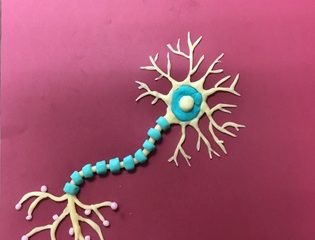Heres what we are reading today:
“Published May 4, 2015, in Nature Neuroscience, the new findings may eventually lead to treatment strategies targeted for the underlying causes of schizophrenia and related disorders, said the study’s corresponding author Scott Soderling, an associate professor of cell biology and neurobiology in the Duke School of Medicine.
Schizophrenia is complex at every level, from genes to brain to behavior, said Soderling, who is also a member of the Duke Institute for Brain Sciences. People with the illness show a wide range of symptoms that vary in severity. Genome-wide association studies have implicated hundreds of mutations that might confer risk.”
“Today, an article published in Cell by Manel Esteller, director of the Epigenetics and Cancer Biology Program of the Bellvitge Biomedical Research Institute (IDIBELL), ICREA researcher and Professor of Genetics at the University of Barcelona, describes the possible existence of a sixth DNA base, the methyl-adenine (mA), which also help determine the epigenome and would therefore be key in the life of the cells.”
“Wei-Chuan Shih, assistant professor of electrical and computer engineering at UH, said the lens can work as a microscope, and the cost and ease of using it — it attaches directly to a smartphone camera lens, without the use of any additional device — make it ideal for use with younger students in the classroom.
It also could have clinical applications, allowing small or isolated clinics to share images with specialists located elsewhere, he said.”
“Although the human ability to write evolved from our ability to speak, writing and talking are now such independent systems in the brain that someone who can’t write a grammatically correct sentence may be able say it aloud flawlessly, discovered a team led by Johns Hopkins University cognitive scientist Brenda Rapp.”
““Until now, people with upper-limb disabilities have been limited to PCs if they want to use computers,” said developer Ahn Hyun-jin, a student at Seoul National University’s Graduate School of Convergence Science and Technology.”
“A key challenge in neuroscience research is identifying organizational principles of how the brain integrates sensory information from its environment to generate behavior. One of the major determinants of these principles is the structural organization of the highly complex, interconnected networks of neurons in the brain. Dr. Oberlaender and his collaborators have developed novel techniques to reconstruct anatomically-realistic 3D models of such neuronal networks in the rodent brain. The resultant model has now provided unprecedented insight into how neurons within and across the elementary functional units of the sensory cortex – cortical columns – are interconnected.”
“”It would be wonderful if we could use tDCS to enhance cognition because then we could potentially use it to treat cognitive impairment in psychiatric illnesses,” said Flavio Frohlich, PhD, study senior author and assistant professor of psychiatry, cell biology and physiology, biomedical engineering, and neurology. “So, this study is bad news. Yet, the finding makes sense. It means that some of the most sophisticated things the brain can do, in terms of cognition, can’t necessarily be altered with just a constant electric current.””
“PhD student David Troy and Dr Angela Attwood from Bristol’s Tobacco and Alcohol Research Group presented the study as part of a symposium on ‘Environmental influences on food and alcohol-related behaviour’.”




13 Comments
maggisamson · May 6, 2015 at 10:41 pm
Perhaps it’s because I’m a college student but the article about the influence that the design of a glass has over the amount of alcohol consumed jumped out as very interesting to me. We are all taught in the early months of college how the classic red party cup has established markings meant to show the serving size of different forms of alcohol, yet in a dark room with an opaque cup, it’s unlikely that all of my peers would be able to judge how much well their beer complies with the actual serving size. I can definitely see the potential benefits with having markings on a glass cup with the prevention of alcohol overconsumption as an easier way to count drinks and to take note of the rate of consumption. In addition, the straight sides of the cup make it so it’s easy to estimate the volume of the glass, whereas a shorter but curved glass may give the impression that you drank less than you actually did. Despite the aesthetic appeal of the glass may be lessened, the consumers will be given a much more straightforward idea of how much they are drinking and potentially decrease the likelihood that they will drink excessively. These kind of concepts would be beneficial in a college setting, where incidents due to excessive drinking are very prominent.
OwenHevrdejs · May 7, 2015 at 7:10 pm
Hello!
I really enjoyed the article about the microscope lens. I think that this is a huge advancement, as it is incredibly inexpensive to produce the new lens. I can see them as a very useful tool in education. Microscopes of this strength cost about ten thousand dollars, so most schools don’t have very many. With these lens, things observable by microscope can be exposed to children at even younger ages! I think that’s a great thing, and will help future students! Thanks for posting!
Owen
hannahburgardt · May 8, 2015 at 1:07 pm
I have a deceased relative who suffered from Schizophrenia and he died at an early age. He didn’t die because of the disease, but due to Schizophrenia, he lived a very difficult life. It would be very interesting to see more research about the genetic components of this mental disease. No one else in my family had that disease which was very interesting. I know that Schizophrenia is a combination of environmental factors and genetic factors, however, it would be very helpful to society to know specific genes and specific environmental factors in order to prevent this disease.
meteresi · May 9, 2015 at 10:38 am
I read the article about schizophrenia treatments. It does sound like schizophrenia is incredibly complex! It is also so devastating. I grew up outside of Washington DC and saw firsthand that many of the homeless in our nation’s capitol appear to have schizophrenia. I have heard that many prisoners have schizophrenia as well. Personally, I knew someone in high school that was perhaps the most intelligent guy in our graduating class, yet the last couple of years of high school he developed schizophrenia and from then on he has barely been able to function. It seemed like the medications he had to take also made him extremely tired. It was really sad to watch someone with such high potential deteriorate so much. I am hopeful that better understanding of the biology behind schizophrenia will lead to better treatment and better outcomes for those who are effected.
rjoslin · May 9, 2015 at 12:40 pm
The article bout the sixth base wait is fascinating. I am currently taking a genetics course and epigenetics is a really interesting topic. I think its really cool that our genes will express differently based on our environment such as mC. With mC regulating many different cell expressions it seems that the possibilities of a sixth base mA another epigenome base could lead to discoveries of how certain genes express traits. It will be exciting to see if trying to understand how this base affects our genes can lead to more information about genetic diseases and our overall understanding of the human genome.
slbonill · May 10, 2015 at 10:53 pm
I read the article on how the shape of the glass influences the speed of alcohol consumption. I found this article very interesting because I didn’t think that something as small as appearance of something can affect something was greatly. As I was reading this article I thought about the idea of conservation and how children at a young age are unable to understand this concept. The idea of conservation is that the shape of something does not affect the amount of substance in something. I would think that similarly the shape of something would not affect the rate of alcohol consumed. Maybe because a marked glass is marked, our brains are aware and more cautious of how much we drink because we have something to judge it and compare it to. Whereas without the glass being marked, we are unconscious of how much liquid or alcohol is being consumed because we do not have that point of reference that the labeled glass has and therefore we forget how much is being consumed.
anniethacker · May 11, 2015 at 5:43 pm
I read the article about beer consumption. I was definitely surprised by that. I thought that people continued to drink or stopped drinking based on if they were at the “level” they wanted to be at. I didn’t realize that the glass could have a difference. I wonder if companies will start to make changes to their glasses because of this. It also makes me wonder what other little changes companies could make that could decrease unhealthy habits (like overeating or smoking.) It’s definitely a cool idea to keep in mind.
michellevanriper · May 12, 2015 at 10:06 am
I read the article on how glass shape influences how fast we drink. I thought this was a really interesting article and very good information to have! I always knew that I drank slower in lets say a sour beer glass or a stella beer glass then I did in a regular straight pint size glass but it’s nice to know that it’s not just me. The findings from this study are a good starting point but I think it is really essential to understand why beer drunk in these two types of glasses differ. My thought was that pint glasses are usually for a lighter beer and shorter more stout glasses were for very heavy or flavorful beer. I thought that this was why you drank them slower, because they were more flavorful and you were drinking them to sip and taste, not to chug. I also thought it was interesting that people drank slower if it showed measurements on the glass. This also made sense to me because it’s kind of like eating your food right next to a scale or something. You have to think more about what your actually eating and the thought of gaining weight is present in your mind. However, I’m not sure how many bars will actually want to implement glasses that have measurements on the side because their profit will probably decrease.
slippp3 · May 13, 2015 at 12:41 pm
I read the article about how smart phones can be used as microscopes and I thought it was SO very interesting. Seeing how far smart phones have evolved since cell phones were even first invented. Also something that surprised me was how the lens only costs three cents. As opposed to actual microscopes that are thousands and thousands of dollars. It’s crazy how far we have come with technology and I can’t even imagine what will be invented a decade from now.
mehicks · May 19, 2015 at 3:43 pm
I read the article about schizophrenia and it reminded me an article that I had read recently about alzheimers and a new biotech company called Denali. The article, written by Matthew Herper on Frobes.com wrote, “He says that just as oncogenes – cancer genes – have lead to a flood of cancer drugs, newly discovered genes linked to degenerative brain disease (the Denali guys called them degenogenes) will provide a basis for a new generation of brain medicines”. After reading the article regarding schizophrenia, it seems that with the combined understanding of Arp 2/3, hyperactive neurons and the dopamine hypothesis, the future of schizophrenia treatment will involve prevention rather than intervention. I think that with the biotechnology’s continued rise, we will continue to see genetic research for prevention rather than a medicine to mask the symptoms of diseases. With the growing familiarity of epigenetics and the important role that it could play in our future as well as the biology of the brain, this type of ground breaking research will become more and more apparent.
esmeraldadiego · May 23, 2015 at 10:36 am
I read the article about the 6th DNA base. I think that with the advent of the 6th base it may become possible to answer many of our questions regarding complex genetic disease. However, as is often the case with genetics, the 6th base may also lead to more questions and increasing complexity in the biological and chemical aspects controlling our genetics.
jnader · May 23, 2015 at 11:11 am
I read the article about Schizophrenia that detailed the three different theories of how one’s brain functioning relates to the symptoms one with schizophrenia may experience. This article was especially interesting for me not only because I am very drawn towards abnormal psychology, but also because it explained parts of a mental disorder that, to me, seems unfathomable. Not only did the article detail the differences between the brain abnormalities such as the spine pruning theory, hyperactive neurons theory, and dopamine hypothesis, but it also described how these three different brain workings are interrelated in how they effect one’s behavior. Each issue almost had like a domino effect which somewhat explains the many facets of abnormality that a schizophrenic patient has. What was also interesting is it not only said why the brain this way causes a person to behave a certain way, but it also explained why certain drugs help curb these symptoms. If one has excessive dopamine in their system then it makes sense that psychoactive drugs would help reduce this level and restore a sense of ‘normalcy’ in the patient. Overall, I found reading this article incredibly beneficial and it really helped me better understand such a confusing disorder.
mkpolo · June 5, 2015 at 5:49 pm
I personally found the article correlating design of drinking glass and rate of alcohol consumption to be very interesting. It most likely has something to do with me college student. Seeing as how college students are surrounded by a binge drinking culture, I believe tackling this serious in creative ways is imperative. However, one issue I could see is this being turned the other way by marketers. Finding a simple way to increase consumption of alcohol may seem like an easy way to profit for bar owners. As is often the case in many psychological findings, I find it once again important to err on the side of caution in regards to psychological findings, due to how people choose to use such findings. All in all, what I find most interesting is how we can be implicitly motivated to drink more or less based on such seemingly insignificant factors.